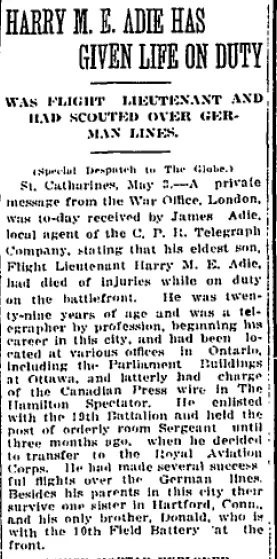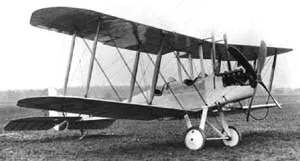Adie, Harry Morton Ellis (Flight Lieutenant)
Killed in Flying Accident 1916-May-01


Birth Date: 1887-August-12
Born: St. Catharines, Ontario
Parents: Mr. James Adie & Mrs. Clara Adie
Spouse: unmarried
Home: St Catharines, Ontario
Enlistment: Hamilton, Ontario
Enlistment Date: 1916-February-01
Service
RNAS
Unit
8 (BR) Sqn- Squadron (RNAS)
Base
France
Rank
Flight Lieutenant
Position
observer/gunner
Service Numbers
55970
B.E.2c serial: 4180

The Royal Aircraft Factory B.E.2 is a British single-engine tractor two-seat biplane, designed and developed at the Royal Aircraft Factory. Most of the roughly 3,500 built were constructed under contract by private companies, including established aircraft manufacturers and firms new to aircraft construction.
Early versions entered squadron service with the Royal Flying Corps in 1912 and the type served throughout the First World War. Initially used as a reconnaissance aircraft and light bomber, as a single-seat night fighter the type destroyed six German airships between September and December 1916.
By late 1915, the B.E.2 was proving to be vulnerable to the recently introduced German Fokker Eindecker fighters, leading to increased losses during the period known as the Fokker Scourge. Although by now obsolete, it had to remain in front line service while replacement types were brought into service. Following its belated withdrawal from combat, the B.E. continued to serve in training, communications, and coastal anti-submarine patrol roles.
The B.E.2 became the subject of controversy. From the B.E.2c variant onward, it had been developed to be inherently stable, which was helpful for artillery observation and aerial photography duties. However this stability was achieved at the expense of manoeuvrability; moreover the observer, in the front seat ahead of the pilot, had a limited field of fire for his gun.(Source Wikipedia)